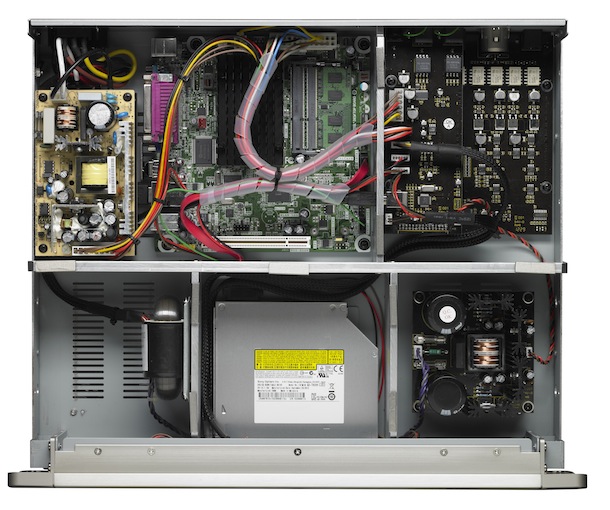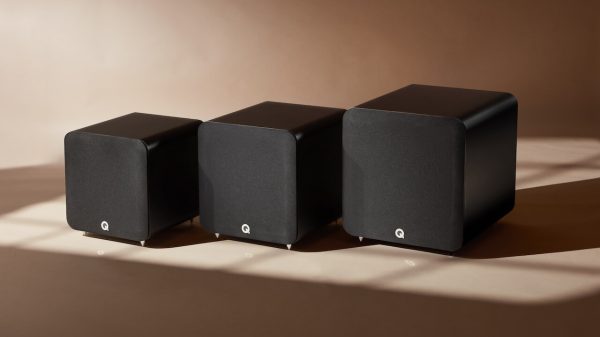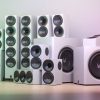Parasound teams with Holm Acoustics to deliver a radically different approach to extracting the best possible sound from a Compact Disc
Parasound introduced the Halo CD 1, which uses a new CD playback and processing technology that is the result of a collaboration between Parasound and Holm Acoustics in Copenhagen, Denmark. The new method for playing CDs is based on using a CD ROM drive instead of a conventional CD drive and a Linux-based computer to read and process the CD data. The CD ROM drive in the CD 1 runs at 4 times the speed of a conventional CD player drive in order to accumulate a vast amount of data. An on-board Intel ITX computer, running the Linux operating system kernel and Holm’s proprietary software dramatically improves the reading of CD disc data. It analyzes CD data and reads every part of a CD as many times as are needed to significantly reduce errors and, accordingly, the negative effects of error concealment. The result is a nearly bit-perfect data stream.
Standard CD players cannot accomplish any of this because CD drives are slow data readers and data must move through the buffer at the same speed it comes off the CD. Unlike the CD 1, standard CD players must transfer data to the DAC as soon as it is read from the CD. As a result, they don’t have time to accumulate enough data in a buffer so that it can be analyzed and processed. It is a significant handicap.
“The CD 1 demonstrates that CDs can sound significantly better than anyone has imagined possible. The full potential of the 16-bit CD format is realized for the first time in the CD 1,” said Richard Schram, Parasound’s president and founder.
The CD 1 offers a unique ‘Discrete OpAmp’ selector that gives users the option of listening to the analog outputs directly from the low noise National LME49990 op-amps or via discrete transistor output stages. The discrete output stage uses individual transistors in a Darlington configuration that operates in the feedback loops of the LME49990s. This subtly changes the sonic character of the CD 1 and there is no “wrong” choice.
Timing is Everything
When data is first received the CD 1’s emphasis is on registering the audio data bit-perfect, rather than focusing on its jitter. Only bit-perfect data is written to the buffer, synchronous with the CD ROM input clock. When the buffer accumulates 30 seconds worth of data, its output process commences with bit-perfect reading, with no jitter from the CD ROM drive at the buffer’s output. The bit-perfect, jitter-free information goes next to an asynchronous USB interface. The flow of this information is controlled directly by a separate ultra-high-precision clock that is totally independent from the CD ROM drive clock. This precision clock is generated by a Connor-Winfield V7123 Voltage Controlled Crystal Oscillator (VCXO) with static DC control voltage. You receive all of the sonic benefits of precision timing from a high end clock whose frequency is absolutely stable.

Choice of a Single Analog Devices AD1853 DAC IC
The CD 1 uses a single AD1853 DAC in stereo mode, rather than a separate DAC for each channel. The choice of a single DAC was not budgetary; it was because a single DAC is inherently free of any inter-DAC delays. The delay between multiple DACs working in parallel can measure up to 10 nanoseconds (10,000 picoseconds) introducing minute amounts of delay into the signal chain. Controlling inter-DAC delay requires additional circuit complexity and individual hand adjustments on each board. For reference, the jitter on the Master Clock to the DAC chip is below 10 picoseconds RMS. To maintain this outstanding level of DAC clocking performance, even the smallest part-to-part timing discrepancy must be avoided.
Onboard the AD1853 the 44.1kHz data is converted to 352.8kHz by 8x upsampling. The upsampling process minimizes the staircase step size of the output current from the audio DAC to achieve the smoothest possible DAC raw output without any related aliasing. This is particularly important because large current source changes that exceed the slew rate of the analog op-amps that are downstream will cause them to generate distortion that impairs audible performance.
DAC Objective Measurements and Subjective Sound
Holm selected the AD1853 DAC IC for its neutral, highly resolving, but still warm sound. The dynamic range specification for the AD1853 DAC is 116dB. While some DACs are rated for a 130dB dynamic range, this does not guarantee a completely satisfying musical experience. Moreover, the 16 bit Red Book CD format corresponds to a maximum dynamic range of 98dB, so a CD player’s DAC performance on bits 17-24 is immaterial.
Analog Section
The quality of the CD 1 analog section is equally important as its digital section. Designing an extremely accurate, stable, and linear digital section is a pointless exercise if the analog section does not have the very lowest possible noise to avoid degrading the purity of the decoded signal. It is for this reason that the CD 1 utilizes National Semiconductor LME49990 op-amps exclusively in its analog section. The LME49990 is designed specifically for ultra-high end audio applications. Their performance actually surpasses the measurement capabilities of the audio industry’s reference, the Audio Precision 2722. Here are few examples of its specifications:
- 0.9 Nano-V per Hz2 noise
- Common Mode Rejection Ratio (CMRR): 137dB
- THD plus noise: 0.00001%
- Power Supply Rejection Ratio (PSRR): 144dB
Outstanding Current-to-Voltage Conversion
The analog signal coming from the AD1853 DAC uses separate LME49990s in a differential output mode to generate a fully balanced signal where the plus and minus phase (or “leg”) of each channel is driven separately with two additional LME49990 op-amps for each channel. This differential-to-single-ended circuit also functions as anti-aliasing filters for the same op-amps. The differential to single-ended converters employ DC servos to insure that DC offset voltage at the analog outputs is negligible. The potential sonic effects of the capacitors in this circuit are far outside the sonic range.
Analog Output Stage
The conditioned analog signal is buffered with yet another pair of LME49990 op-amps for the XLR balanced output connectors. The positive leg of each XLR also drives the same channel’s analog RCA output jack so the RCA and XLR outputs cannot be used at the same time. The CD 1 uses Neutrik XLR connectors for the balanced outputs and gold-plated Vampire RCA jacks for the unbalanced outputs. These parts were selected for the high purity of their base metals, sonic superiority and quality of construction. Parasound uses these same connectors in the Halo JC 1, JC 2 and JC 3.
CD 1 Discrete Analog Output Option
The Discrete-OpAmp button on the CD 1’s front panel gives you the option of listening to the analog outputs directly from the LME49990 op-amps or via discrete transistor output stages. The discrete output stage is a modernized version of the discrete output stage used in the vintage Parasound D/AC-2000 that UltraAnalog designed for Parasound. It uses discrete transistors in a Darlington configuration that operates in the feedback loops of the LME49990s so that the specs for THD and noise are as low as the op-amps alone. The discrete circuit subtly changes the sonic character of the CD 1 and fortunately there is no “wrong” choice.


Using the CD 1 as a Transport – Digital Outputs for a Separate DAC
BNC Coaxial Output
The Parasound CD1 has one coaxial BNC S/PDIF output connector. Only BNC connectors have the correct mechanical dimensions to provide a true 75 ohm impedance at all relevant digital audio signal frequencies. A 75 ohm BNC connector’s impedance precisely matches a 75 ohm cable, insuring that the digital signal is transmitted free of any reflections that might otherwise deteriorate the data flow. The BNC connection maximizes the purity of the signal and yields the highest quality signal with the least jitter.
RCA Coaxial Output
RCA connectors are the industry de facto standard for S/PDIF transmission and the CD 1 has one RCA jack. The RCA link has same specifications as the BNC for impedance. RCA jack dimensions preclude a true 75 ohms impedance which might cause some signal reflections in the digital cable and more jitter than a BNC connection.
Optical Output
The Toslink optical output is useful if all of the coaxial inputs on your DAC are utilized. Be careful to handle optical wires with care; they cannot be bent sharply or damaged without severely compromising their performance. The best results will be obtained with the BNC output.
Isolation of the Digital Outputs
The BNC and RCA digital outputs have two levels of isolation: independent output buffer amplifiers and independent isolation transformers made by Pulse Engineering, Inc. They are optimized for digital signal transmission by providing very high common-mode noise rejection and the elimination of potential ground loops.
Multi-Stage Power Supplies and Voltage Regulators
The Parasound CD 1 uses one high current switch mode power supply for its CD ROM drive and Intel computer and a second standby switch mode standby power supply which consumes a mere 0.5w in standby. This conforms with European Union requirements in effect from January 1, 2013.
The CD 1 has 12 separate point-of-load power supply voltage regulators. Each regulator is assigned to convert voltage downward and maintain it precisely for its assigned analog or digital subsection. 10 voltage regulators are used in the DAC-Analog Output section alone and one regulator is used for the S/PDIF digital links. The USB power is filtered by a dedicated regulator for the clock’s crystal oscillator. Each power rail is carried on its own isolated power plane. Low voltage DC currents from the analog section’s power supply are further noise-shaped by multiple levels of power regulation. Voltage regulation is best performed at the point-of-load to minimize inductance, so each regulator is “local” because it is situated as close as possible to the section of the circuit that it supplies.
A Separate Power Supply for Analog
A separate linear power supply is provided for the analog section because its characteristics are superior for analog reproduction and appropriate for the CD 1’s analog circuit. It uses a low-noise, high-current R-Core power transformer, high speed-soft recovery rectifier diodes and low-ESR Panasonic filter capacitors which are the same type Parasound uses in the Halo JC 2 and JC 3. The power supply also includes an inductor for an additional level of filtering.
Six Layer Circuit Boards
The Digital Input stage is built on a four layer printed circuit board. The DAC-Analog Output stage is built on a six layer printed circuit board. This level of design sophistication and implementation is virtually unheard of in a consumer audio product. These multi-plane circuit boards provide an extremely low impedance ground and extremely low impedance power distribution, resulting in vanishingly low digital noise contamination. Power on the digital input stage and DAC/Analog Output stage circuit boards is distributed on independent circuit board layers called power planes to minimize inductance and resistance and to distribute the capacitive load for the ultra-high speed B+ and B- power rails.
Further Design Considerations
Heavy Shielding Isolates Every Function
The interior of the CD 1 has a network of massive aluminum partitions that isolate each function and circuit from other functions. The analog power supply and its R-core power transformer are each shielded in separate compartments to isolate and shield them from high frequency electromagnetic emissions from the switch mode power supplies, the Intel computer’s processor and clock and the CD ROM drive. Every effort has been made to supply pristine B+ and B- rails so the analog section can achieve its full sonic potential.
The Digital Input stage and DAC-Analog output stage are also enclosed behind thick aluminum shield partitions so that emissions from the power supplies, Intel computer and CD ROM drive cannot detract from their performance. These shield partitions also add mass and rigidity to the CD 1 chassis, making it virtually immune to the effects of external vibrations
No DAC Inputs for External Digital Sources
The CD 1 design and construction is optimized for near-perfect reproduction of the 44.1kHz data in Red Book CDs. Adding DAC inputs to accommodate other digital sources would have involved far more than simply adding digital input connectors and a selector switch. A sample rate converter would have had been added to the audio path compromising CD playback. To provide the same level of performance for CDs while adding external digital inputs would have greatly increased its complexity and price.
Component Parts Criteria
The Intel Single Board Computer
The CD 1’s Intel computer is dedicated to one function: analyzing and processing CD data. The Linux operating system is bulletproof and there are no other programs, so there is little likelihood of it freezing or crashing, as with computers running Microsoft Windows or Apple OS. Enormous heat sinks on the processor chip and clock plus carefully arranged chassis venting provide ample convection cooling without using fans. Passive cooling gives the CD 1 several important advantages: totally silent operation, dust isn’t drawn in to chassis, no dependence on fans which eventually wear out, causing the processor and clock to fail. There is also a sonic benefit of passive cooling. When an electric motor is turning it generates a fluctuating electromagnetic field that contaminates both digital and analog circuits. The audible improvement without fans is real has been demonstrated.
High-Precision Surface Mount Components
Extensive use of lead-free, low temperature coefficient active and passive surface-mount components results in significantly smaller loop areas, reduced circuit capacitance and reduced circuit inductance, introducing less noise than larger conventional “DIP” through-hole mounted components.
Capacitors
The analog section of the DAC board uses NP0 high quality surface-mount capacitors, which are the best SMD capacitors available in small capacitance values. Capacitors that are necessary in the signal path operate only below 1Hz and above 70kHz, with no phase shift or other effects in the audible frequency range.
Resistors
All resistors on the digital input and DAC sections are 0.1% tolerance thin-film surface-mounted. Small thin-film resistors have up to 20dB less “shot noise” or voltage-dependent noise than conventional resistors due to the laser trimming of the thinner resistive film. The laser “burning” pollutes the resistor’s structure and creates shot noise-prone regions. Laser trimming thin film burns more cleanly without polluting the structure, thereby producing less shot noise.
Silent Running
The CD ROM drive in other memory players is noisy whenever it spins up to refill the buffer memory. Not so in the CD 1. Proprietary software enables the CD 1 to run silent while playing an entire CD.
Construction
The Parasound Halo CD 1 is in all aspects a high-end audiophile player in keeping with the legacy of Parasound’s Halo product family. It has a rugged aluminum chassis with extensive shielding for electrical and mechanical isolation. It has three separate power supplies for the analog and digital circuits. The outputs use premium balanced XLR connectors, gold-plated RCA outputs, and S/PDIF Digital audio outputs via 75-ohm BNC, coaxial, and optical connections.
Price and Availability
The Parasound Halo CD 1 Compact Disc Player is offered in both traditional silver chassis and the new all black finish — now shipping for $4,500.






























